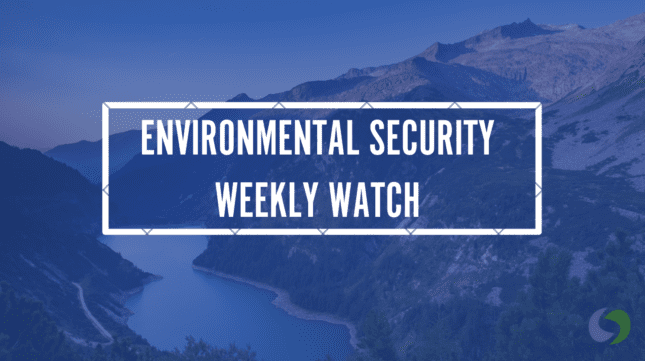-
Environmental Security Weekly Watch: October 13-17, 2025
October 17, 2025 By Madelyn MacMurrayA window into what we’re reading in the Stimson Center’s Environmental Security Program
Assessment of UNESCO Sites Reveals Climate Impacts (Mongabay)
Initial data from the first ever global biodiversity and climate assessment indicates that 98% of UNESCO’s 2,200+ World Heritage Sites, Biosphere Reserves, and Geoparks have experienced at least one climate-related extreme event since 2000, including massive wildfires, droughts, and retreating glaciers. The effort to track such effects will now be augmented by UNESCO’s new Sites Navigator, a geospatial platform that integrates over 40 datasets to track climate impacts, biodiversity loss, and socioeconomic conditions in real time.
If global temperatures rise by just 1°C by 2050, exposure to climate extremes could triple. Projections of what such an event would mean also indicates that all African glaciers will likely disappear by mid-century. Adding to the urgency for such a tool is that approximately 20% of UNESCO sites overlap with Indigenous lands and territories, thus affecting roughly 1.2 billion people who depend on these areas for food, culture, and livelihoods.
READ | Measuring Impact: Building on Lessons Learned to Improve Biodiversity Conservation
Two Months of Superhot Days by 2100 May Create Broad Threats to Humans (Associated Press)
The world is projected to experience nearly two additional months of dangerously hot days annually by century’s end, with an impact distributed in a highly inequitable fashion. Small, ocean-dependent nations like the Solomon Islands, Samoa, and Panama will face the worst consequences (Panama will face 149 extra superhot days), yet these vulnerable countries contributed only 1% of current heat-trapping gases. Meanwhile, major polluters like the United States, China, and India may experience only 23 to 30 additional superhot days, despite being responsible for 42% of atmospheric carbon dioxide.
Health impacts from present extreme heat days are already severe and will worsen significantly, with researchers estimating that tens of thousands (or perhaps millions) of people will be affected. Recent heat waves have become both more likely and more intense: the 2023 southern Europe heat wave was 70% more likely and 0.6°C warmer than it would have been a decade ago. Similar future events will potentially be 3°C hotter by century’s end, if climate action doesn’t increase.
READ | The Next Feminist Wave: Heat
China’s Rare Earth Restrictions Pose Threat to Key Technological Supply Chains (The New York Times)
China has implemented sweeping restrictions on critical rare earth minerals used in computer chips, cars, and missiles, and requires companies worldwide to obtain Beijing’s approval to trade such materials even outside China. It is an approach which directly parallels U.S. rules from 2020 that prohibited any company globally from shipping products to Chinese firms like Huawei if they contained American parts, and demonstrates China’s ability to weaponize supply chains. Indeed, its measures could be more effective due to China’s dominance in rare earth production.
The new restrictions offer extraordinarily broad implications for global semiconductor manufacturing. Companies across the United States, Europe, Japan, India, and South Korea are concerned both about supply chain disruptions as well as the extensive corporate information Beijing is demanding. While China has invested billions to develop a domestic chip industry, the United States may need years to restart rare earth production, a situation that creates an asymmetric vulnerability that gives China a stronger negotiating position.
READ | Mine the Tech Gap: Why China’s Rare Earth Dominance Persists
Sources: Associated Press; Mongabay; The New York Times; UNESCO
 A Publication of the Stimson Center.
A Publication of the Stimson Center.







